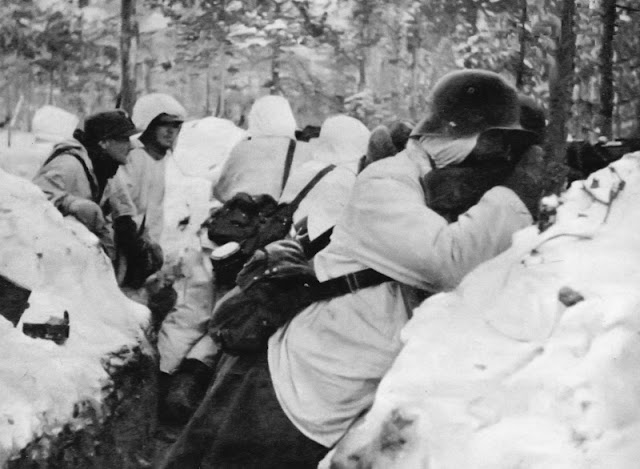Tuesday 12 December 1939
 |
| Finnish skiers beside a pile of Russian corpses. |
Colonel Hjalmar Siilasvuo has the Soviet 163rd Rifle Division surrounded at Suomussalmi. His troops have the only way in, the Ratte road, barricaded, but there still is no sign of any Soviet relief effort. He and his men wait.
At Taipale, the Soviets continue trying to smash through the Finnish defenses using only one division. By the end of the day, the Soviet commanders decide to bring in another division, the 10th Rifle Division, and more tanks and artillery. It will take a day or two for these to arrive.
The Finnish defenses at Kollaa also are holding. This is the linchpin of the entire Mannerheim Line and it is well-defended.
At Tolvajärvi, north of Lake Ladoga, the Finnish commander, Colonel Paavo Talvela, sees an opportunity to trap some Soviet troops by sending his troops across the frozen lakes Hirvasjärvi and Tolvajärvi. He sends one group in the north, consisting of two battalions, to attack the Soviet 718th Rifle Regiment. While the attack fails, it draws off Soviet reserves needed in the south. There, a Finnish battalion of the Finish 16th Regiment fends off a Soviet attack in the morning and goes on the offensive as planned. The Soviet troops are pushed back, and Talvela traps the entire Soviet Regiment, capturing its documents and killing its commander. The Soviets army loses over 1,000 dead and equipment (including 26 tanks) that the Finns can badly use. The Soviet 139th Rifle Division is largely destroyed.
The Soviet troops in the far north at Petsamo are being screened only lightly by the Finns, but there is really nowhere for them to go in the round-the-clock darkness of the Arctic winter.
The only Soviet bright spot is at Salla, in the waist of the country. The Soviets are consolidating their advance there, ridding the town of the remaining Finnish troops, and planning their next move west.
Winter War Naval Operations: Soviet submarine SC-311 sinks Finnish freighter Wilpas.
 |
| The Bremen (Ang, Federal Archive). |
HMS Barham and HMS Duchess collide in the Mull of Kintyre nine miles off the Scottish coast in dense fog. Barham being a battleship and Duchess a destroyer, the later is cut in half and goes to the bottom. There are only 25 survivors and 124 perish.
The 496-ton British freighter Marwick Head hits a mine and sinks south of North Caister Buoy in the English Channel. Five survive and five perish.
The Admiral Graf Spee arrives off the River Platte estuary late in the day and spots the British Force G waiting for him. Captain Langsdorff is under orders to avoid combat. Since he is at the end of a long cruise after four months at sea, he takes those orders lightly, as some damage can be repaired in port while the engines are serviced. He dumps the Arado seaplane, removes extraneous equipment and prepares for battle. It is a fateful decision.
Kriegsmarine destroyers conduct more mine-laying operations in the English Channel.
German U-boat U-50 commissioned.
European Air Operations: The RAF begins occasional patrols over the Frisian Islands being used by Luftwaffe seaplanes to lay mines. They bomb Luftwaffe bases at Borkum and Sylt.
League of Nations: The Soviets say "Nyet!" to the League's offer to mediate and for a ceasefire.
British Government: Winston Churchill goes to Parliament and argues that Great Britain should invade Norway, stating, "it is humanity, and not legality, that we must look to as our judge."
General Wavell returns to the Middle East.
Convoy HX 52 departs from Liverpool and HX 12 from Halifax.
German Government: Hitler orders a doubling in the production of magnetic sea mines and munitions in general.
Admiral Raeder, who supports an invasion of Norway, tells Hitler about a meeting with pro-German Norwegian politician Vidkun Quisling. Hitler is intrigued and agrees to meet Quisling.
China: The Chinese Winter Offensive gets rolling:
- Chinese 5th War Area (western Anhwei, northern Hupei, and southern Honan with 22nd, 29th, 31st, and 33rd Army Groups) opens offensive around Chienchiang, Pailochi, Hsientao, Loyangtien, and Hsuchiatien;
- Chinese 9th War Area (northwest Kiangsi, Hupei south of Yangtze River, and Hunan with 1st, 15th, 19th, 27th, and 30th Army Groups) opens attacks around Wanshoukung, Tacheng, Kulopu, Shihtoukang, Kaoyushih, Hsiangfukuan.
American Homefront: Actor Douglas Fairbanks passes away at 56 of a heart attack.
December 1939
December 1, 1939: Finland Fights for its LifeDecember 2, 1939: First RAF Bombs on Germany
December 3, 1939: Soviets Still Advancing in Finland
December 4, 1939: Molotov to Roosevelt - Mind Your Own Business
December 5, 1939: Prien Returns
December 6, 1939: Attacks on Mannerheim Line
December 7, 1939: Kollaa Holds!
December 8, 1939: Polish Pilots Return
December 9, 1939: First British BEF Fatality
December 10, 1939: The Soviets Capture Salla in Finland
December 11, 1939: Finns Make Their Move
December 12, 1939: Finnish Success in the Winter War
December 13, 1939: Battle of River Platte
December 15, 1939: Chinese Winter Offensive in High Gear
December 16, 1939: Battle of Summa
December 17, 1939: End of Admiral Graf Spee
December 18, 1939: Battle of Heligoland Bight
December 19, 1939: British Disarm Magnetic Mines
December 20, 1939: Finnish Counterattacks Continue
December 21, 1939: Finns Plan More Counterattacks
December 22, 1939: Enter Chuikov
December 23, 1939: Failed Finnish Counterattack
December 24, 1939: Soviets on the Run
December 25, 1939: Fresh Soviet Attacks
December 26, 1939: Vicious Battles at Kelja
December 27, 1939: Grinding Finnish Victories
December 28, 1939: Liberators
December 29, 1939: Finns Tighten the Noose
December 30, 1939: Finnish Booty
December 31, 1939: Planning More Soviet Destruction
2019

No comments:
Post a Comment